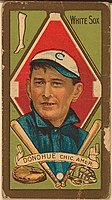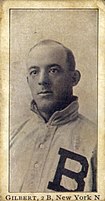
Back Tripleplay Spanish Triple jeu French Triplo gioco (baseball) Italian 三重殺 Japanese 삼중살 Korean Potrójny aut Polish Queimada tripla Portuguese 三杀 Chinese
Jiggs Donahue, Billy Gilbert, and Bill Friel (left to right) of the Milwaukee Brewers recorded the first triple play in American League history on July 14, 1901, against the Chicago White Stockings.[1]
In baseball, a triple play (denoted as TP in baseball statistics) is the act of making three outs during the same play. There have only been 737 triple plays in Major League Baseball (MLB) since 1876,[1] an average of just over five per season.
They depend on a combination of two factors, which are themselves uncommon:
- First, there must be at least two baserunners, and no outs. From analysis of all MLB games from 2011 to 2013, only 1.51% of at bats occur in such a scenario.[2] By comparison, 27.06% of at bats occur with at least one baserunner and fewer than two outs,[2] the scenario where a double play is possible.
- Second, activity must occur during the play that enables the defense to make three outs. Common plays, such as the batter striking out or hitting a fly ball, do not normally provide an opportunity for a triple play. A ball hit sharply and directly to an infielder, who then takes very quick or unanticipated action, as well as confusion or mistakes by the baserunners, is usually needed.
In baseball scorekeeping, the abbreviation GITP can be used if the batter grounded into a triple play.[3]
- ^ a b "SABR Triple Plays database". SABR. September 2024. Retrieved September 25, 2024.
- ^ a b Dolinar, Sean (August 9, 2014). "MLB — Bases Loaded. No Outs. No Runs". stats.seandolinar.com. Retrieved October 28, 2016.
- ^ Noble, Marty (June 2, 2015). "Triple-play threat: Robinson holds infamous mark". MLB.com. Retrieved September 7, 2020.


